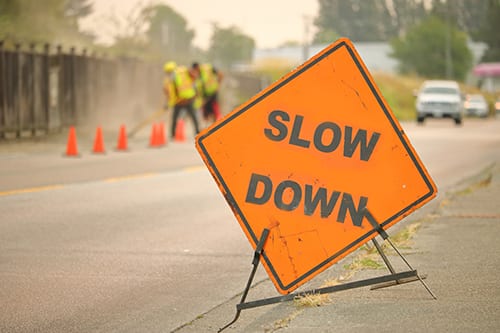 Construction crew members operating on busy roadways are at higher risk of being struck by moving vehicles or equipment than other job sites, which is why it’s crucial to have a road construction safety plan.
Construction crew members operating on busy roadways are at higher risk of being struck by moving vehicles or equipment than other job sites, which is why it’s crucial to have a road construction safety plan.
We live in a busy world – one where more drivers are using our nation’s roads than ever before. They’re often distracted or impatient, which can be bad news for construction workers. On average, 100 of these workers are killed and more than 20,000 are injured each year doing highway work, according to the National Institute for Occupational Safety and Health (NIOSH).
Keep reading for some helpful tips on how to keep workers safe in dangerous highway work zones.
Creating a road construction safety plan
Communication is key on any job site, but it’s especially important when there is lots of moving traffic and equipment. That’s why crews should start each day with a safety toolbox talk. This is a key part of any road construction safety plan because it helps promote awareness and a safety culture, helping to protect both crew members and travelers.
While road construction safety plans are often influenced by state and federal laws, it’s important to take safety a step further by tailoring the plan to a specific road construction site. Crews should know exactly how they’re going to control traffic flow, making sure drivers are aware of upcoming construction conditions. All cones, barrels, barriers, signs and other control mechanisms must be in compliance.
Additionally, it goes without saying that once a plan is set, workers need to follow it. For the sake of everyone’s safety, supervisors need to constantly enforce safety rules with daily inspections. For example, it’s important to make sure that cones and barrels haven’t been pushed into traffic lanes, that signage is placed correctly and that everyone is wearing the proper personal protective equipment (PPE). Accountability is the goal while complacency is the enemy.
6 tips for protecting highway workers
- Be alert. Workers should avoid blind spots, such as walking behind large equipment or vehicles. It’s helpful to have a spotter who can use specific hand signals and verbal warnings to alert co-workers of potential danger.
- Stay visible, especially at night. The risk of worker and driver accidents increases at night. It’s important for workers to wear hi-vis apparel and utilize intrusion devices, which alert crews if a car has toppled a nearby construction barrier. Installing temporary lighting is also helpful.
- Understand road conditions. Remember that rural work areas are typically different than urban ones.
- Separate material storage and parking areas from the job site. These things can easily get in the way and become a hazard.
- Set up designated walking areas. This will improve job site flow and keep workers safe.
- Consider partnering with law enforcement. Depending on law enforcement availability, this can be a helpful tactic in more complicated and busy road work job sites.
Related posts
Hard hat safety | Head protection tips with PPE basics, OSHA guidelines
Hi-vis clothing regulations | Why you should replace worn-out reflective apparel